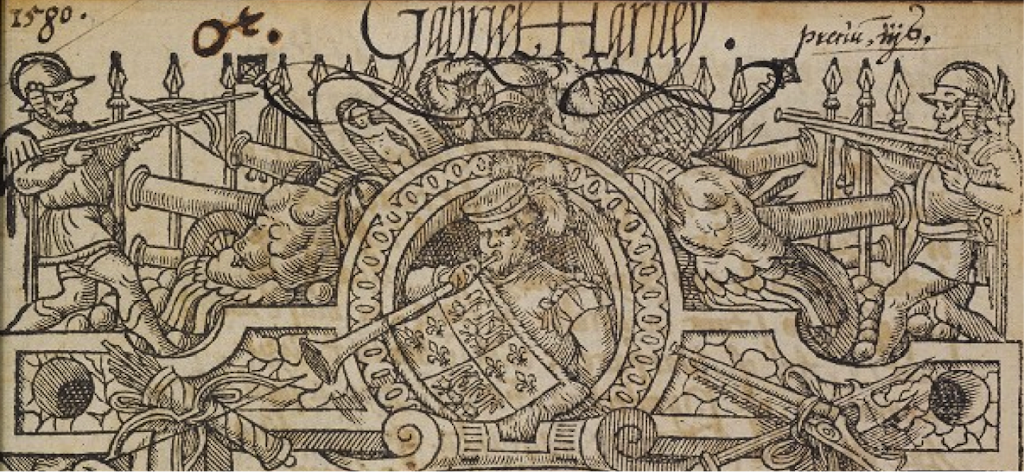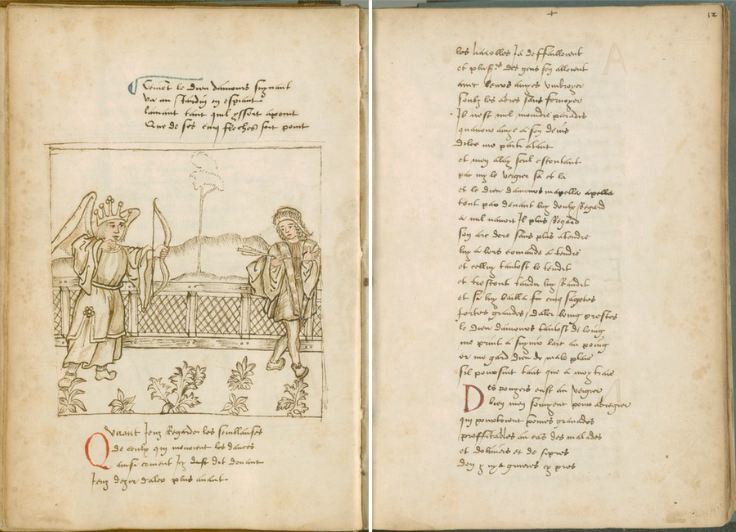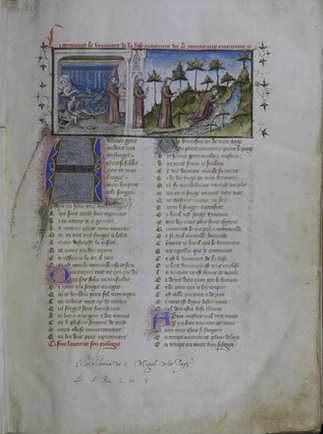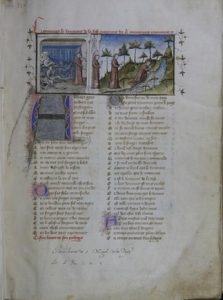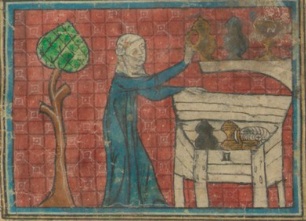Website Launch: The Archaeology of Reading in Early Modern Europe
September 2014 Updates
Funding for ‘Archaeology of Reading’
The Sheridan Libraries of Johns Hopkins University are delighted to announce an award of $488,000 from the Andrew W. Mellon Foundation for the new digital humanities research initiative “The Archaeology of Reading in Early Modern Europe.” In conjunction with University College London’s Centre for Editing Lives and Letters (CELL), and the Princeton University Library, the project will explore historical reading practices through the lens of manuscript annotations preserved in early printed books.
The initiative is under the leadership of Hopkins’ Earle Havens, the William Kurrelmeyer Curator of Rare Books and Manuscripts at the Sheridan Libraries, who will be working with co-Principal Investigators Professor Lisa Jardine, Director of CELL at University College London; and Professor Anthony Grafton of the Department of History at Princeton.
Over the past decades there has been a great deal of humanistic research focused upon the Printing Revolution of the sixteenth century and the reading habits of early modern book owners who filled their tomes with interpretative handwritten marginalia. These annotations still offer a wealth of untapped research materials, which demonstrate how readers adapted to the new print medium.
The initial phase of activity of the project will focus around the transcription and translation of a select number of heavily annotated books, and the allied adaptation of the open-access SharedCanvas viewer to maximize user interaction with these complex, composite early modern texts through a publicly available website. The development of the SharedCanvas viewer will also benefit the Roman de la Rose Digital Library, which will be using this technology in the future to display and digitally annotate Rose manuscripts.
For further information view the Hopkins press release or contact Brian Shields. Tel: 410-516-8337/443-631-2890; email: bshields@jhu.edu.
Rose on Twitter
For those of you who are regular visitors to the Roman de la Rose Digital Library blog, you will probably be noticing some changes. In addition to a slight makeover of our blog style, the most obvious new feature is our fabulous Twitter feed in the right hand column.
Since the beginning of May our Twitter handle, @RoseDigLib, has been hosting some experiments with medieval ‘twitterature’. The project was conceived by Tamsyn Rose-Steel (@TamsynMedieval), CLIR/Mellon postdoctoral fellow at Johns Hopkins University, and utilizes the talents of poet Mike Rose-Steel (@MikeRStyping), who is a PhD candidate at Exeter University and is funded by Exeter’s ‘Bridging the Gaps’ Wiring Wittgenstein project. Guillaume de Lorris’s original poem of around 4,000 lines has been rendered into approximately 200 tweets in modern English rhyming couplets and quatrains, often accompanied by some of the stunning manuscript images that we host here on the Rose Digital Library. Follow us to enjoy this new rendering of the Rose.
To explain the philosophy behind the endeavor and how we handled the constraints on the Twitter medium, some pages will be added to this blog exploring our ideas in greater depth. The first mini-essay ‘Medieval Twitterature’ has already been posted – click on the tab under the header to start reading. We hope you enjoy experiencing this most seminal of medieval French works in a new way.
2013 Usage Statistics
After another long delay, we promise to get back on track with posting these statistics. Please comment if you find these interesting, and if so, how often you would like to see them. For a start, here is 2013.
24,476 visits from 136 countries or territories
The top five countries represented (in order): United States, France, United Kingdom, Canada, Italy
14,579 absolute unique visitors
42% of these visitors have returned to the site
804 of these visitors have used the site 9-14 times
693 of these visitors have used the site 15-25 times
737 of these visitors have used the site 26-50 times
517 of these visitors have used the site 51-100 times
598 of these visitors have used the site 101-200 times
1,968 of these visitors have used the site more than 200 times
1,634 of these visits lasted between 10 and 30 minutes
1,363 of these visits lasted longer than 30 minutes
Since the launch of the site in September 2008 through December 31, 2012, the Rose team has noted the following usage statistics:
111,968 visits from 170 countries or territories
The top five countries represented (in order): United States, France, United Kingdom, Italy, Canada
71,456 absolute unique visitors
36% of these visitors have returned to the site
3,533 of these visitors have used the site 9-14 times
3,157 of these visitors have used the site 15-25 times
3,065 of these visitors have used the site 26-50 times
2,665 of these visitors have used the site 51-100 times
2,479 of these visitors have used the site 101-200 times
4,334 of these visitors have used the site more than 200 times
8,127 of these visits lasted between 10 and 30 minutes
6,125 of these visits lasted longer than 30 minutes
2012 Usage Statistics
We have not shared our usage statistics in quite some time, so here is some information about use of the Roman de la Rose Digital Library for the period January 1, 2012-December 31, 2012:
23,478 visits from 126 countries or territories
The top five countries represented (in order): United States, France, Italy, United Kingdom, Germany
14,707 absolute unique visitors
39% of these visitors have returned to the site
769 of these visitors have used the site 9-14 times
728 of these visitors have used the site 15-25 times
688 of these visitors have used the site 26-50 times
771 of these visitors have used the site 51-100 times
684 of these visitors have used the site 101-200 times
629 of these visitors have used the site more than 200 times
1,777 of these visits lasted between 10 and 30 minutes
1,298 of these visits lasted longer than 30 minutes
Since the launch of the site in September 2008 through December 31, 2012, the Rose team has noted the following usage statistics:
87,522 visits from 161 countries or territories
The top five countries represented (in order): United States, United Kingdom, France, Italy, Spain
57,202 absolute unique visitors
35% of these visitors have returned to the site
2,729 of these visitors have used the site 9-14 times
2,464 of these visitors have used the site 15-25 times
2,328 of these visitors have used the site 26-50 times
2,148 of these visitors have used the site 51-100 times
1,881 of these visitors have used the site 101-200 times
2,366 of these visitors have used the site more than 200 times
6,493 of these visits lasted between 10 and 30 minutes
4,762of these visits lasted longer than 30 minutes
Three new manuscripts added to Rose library
The Roman de la Rose Digital Library team proudly announces the addition of three new manuscripts to our digital library. These additions bring the total number of manuscripts up to 145. This new batch is especially interesting because they are owned by libraries outside of France–we have two new German manuscripts and one from Spain. Each of these were originally produced in France in the 14th and 15th centuries.
Our first new manuscript, BH Ms. 387 comes to us courtesy of the Bibliotèca Històrica of the Universitat de València. With more than 160 beautiful miniatures, this manuscript is one of the most lavishly illustrated in the collection. Many of the illustrations span two columns in width. Heidrun Ost wrote an extensive essay about the illustrations in this manuscript. While it is not certain who commissioned the work, there is speculation that it was Philip the Bold, Duke of Burgundy. The style of illumination is similar to other manuscripts that the duke ordered for his collection. The Valencia Rose contains the usual text plus the “Testament de Jean de Meun”, the “Codicille de Jean de Meun”, and the “Articles de la Foy”.
The second new manuscript, Cod. gall. 80 is part of the collection of the Staatsbibliothek zu Berlin. This 14th century manuscript has smaller and fewer miniatures than our Valencia example, but they are all in brilliant colors. In addition, there are many decorated initials on every page.
Finally we have Ham. 577, also from the Staatsbibliothek zu Berlin. In addition to the text of the Roman de la Rose, this manuscript has a “mystery” section at the end. This section has many geometric illustrations, and does not appear to relate to the Rose. Can you help us with this? Please post a comment on this blog post if you can help with any information.
We owe a big debt of gratitude to the two libraries that supplied the images for these manuscripts. It is this type of community cooperation that enables us to continue to build this digital library.
“L’art d’aimer du Moyen Âge: Le Roman de la rose”
The Roman de la Rose Digital Library is currently being featured in an important exhibition called “L’art d’aimer du Moyen Âge: Le Roman de la rose” at the Bibliothèque de l’Arsenal in Paris. The exhibition began on 6 November 2012 and will close 13 February 2013. The exhibition displays around 100 manuscripts and a few printed editions.
On January 18, 2013 there will be a day-long workshop in which a group of Roman de la Rose scholars will discuss the question “Why should one read the Roman de la Rose today?”. Professor Stephen Nichols of the Johns Hopkins University will close the exhibition with a lecture about how and why digitization makes reading the Rose more meaningful today.
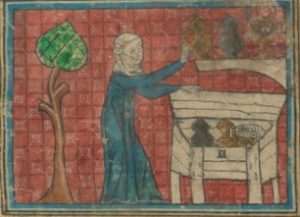 |
| Portrait of Covoitise from Fr. 378 |
Finally, the newest issue (no. 42) of the journal “Art de l’enluminure” features two articles about the Roman de la Rose. The first article discusses Fr. 378 and Rothschild 2800 and the second covers Fr. 25526. We are always interested in hearing about your Roman de la Rose scholarship, so please keep us informed via the “contact us” on the website.
New manuscript images available
The Roman de la Rose Digital Library has recently been updated with three new manuscripts from two German Libraries. This brings the total number of manuscripts on the site to 142! The three new manuscripts are:
- A.B. 142 is a 14th century manuscript from the Kunstakademie Düsseldorf. This manuscript contains many especially nice miniatures and decorated initials.
- Augsburg Cod. I.4.2 3 is a 14th century manuscript in the collection of the Universitätsbibliothek Augsburg. While this manuscript has only a few miniatures, it has many beautiful decorated initials.
- Augsburg Cod. I.4.2. 4 is a 14th century manuscript fragment from the Universitätsbibliothek Augsburg.

